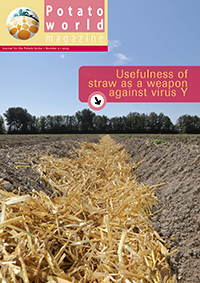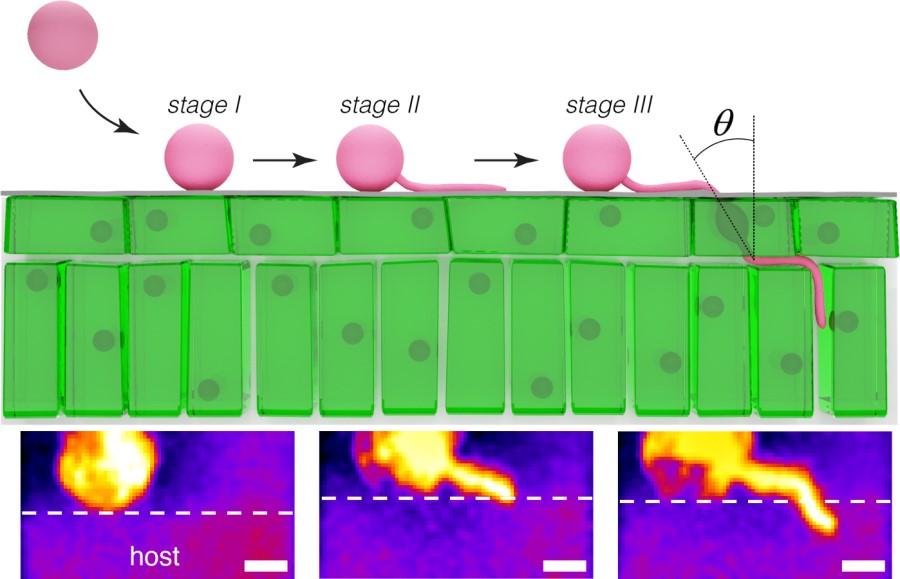Already a subscriber? Activate your premium account

Potatoworld Magazine

Research results by Wageningen scientists open up new avenues for protecting crops more effectively, efficiently and sustainably against Phytophthora infestans.
In a unique collaboration, Wageningen University & Research (WUR) experts in plant pathology, cell biology and physics have found an answer to the question how the pathogen Phytophthora infestans mechanically gains entry through the protective layer on the leaves of crops.
The notorious pathogen Phytophthora infestans poses a major threat to global food production. It has long been a mystery how this microscopically small organism and other members of the Phytophthora genus mechanically gain entry through the protective layer on the leaves of crops. The discovery by the group of WUR experts not only answers this question, but also provides new leads to making the control of Phytophthora more effective, more efficient and more sustainable on the long term.
‘Combatting Phytophthora is and remains problematic, in part because the pathogen and its target are engaged in an ongoing arms race. Tremendous resources are invested in the development of resistant crops through plant breeding, with the aim of becoming less dependent on chemical crop protection. There is also increasing interest in new forms of mixed cropping’, the press statement reads. ‘Another option has now arisen; preventing Phytophthora from gaining access to a plant altogether. Plants come equipped with a protective layer that serves to keep intruders like Phytophthora out. Yet, this microscopically small pathogen (smaller than one tenth of the thickness of a human hair) is able to penetrate this layer and initiate its disease process in plants. Despite decades of research, it remained unknown how they mechanically penetrate this layer. To solve this problem, WUR plant pathologists and cellular biologists joined forces with WUR physicists. The latter are specialists in mechanics, a branch of physics that studies how objects and materials move and respond under the action of forces acting upon them. Their combined knowledge, and new research tools developed in collaboration, could finally bring resolution to this puzzle.’
‘We discovered that Phytophthora uses clever tricks to sharpen its tubular infection structure to then cut through the surface of the plant with a sharp knife. Using this strategy, Phytophthora is able to infect its host, without brute force and with minimal consumption of energy. This is the first time that this mechanism has been uncovered, and really a fundamental discovery,’ says Joris Sprakel, professor in Physical Chemistry and Soft Matter. Phytopathology Professor Francine Govers sees plenty of leads to make the control of Phytophthora more effective, more efficient and more sustainable in the long run, without the usual suspects – chemicals and plant breeding – to circumvent the arms race. ‘The laws of mechanics tell us that Phytophthora is unable to penetrate the plant without first attaching itself tightly to the leaf surface’, Govers mentions. To test this idea, as initial proof of feasibility, the research team sprayed the leaves of potato plants with a non-toxic and inexpensive substance that removes the leaf’s stickiness. This resulted in a reduction of around 65 percent in the level of infection. The effect even rose towards 100 percent in an optimised trial on artificial surfaces.
Apart from the fundamental breakthrough and investigating tools for combatting this kind of plant disease from a new perspective, the research also resulted in a new methodology; a kind of rapid testing method, that can reveal the effect and efficiency of pesticides in a rapid, accurate and inexpensive way. According to WUR, these novel tools could also make a significant contribution to the ongoing battle against plant diseases. ‘Thanks to the engagement of Joris Sprakel and his team, including PhD candidate Jochem Bronkhorst, we now know that there are a number of fundamental physical principles that could give a new twist to the arms race between pathogens and plants. All in all, this research is a truly wonderful example of how collaboration across disciplinary borders can lead to breakthroughs’, Govers concludes. The findings of this WUR expert group are published in Nature Microbiology.
Events
©2015 - 2024 Potatoworld | Webdesign and realisation COMMPRO